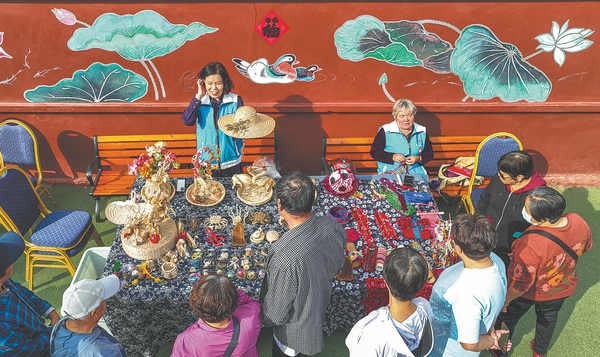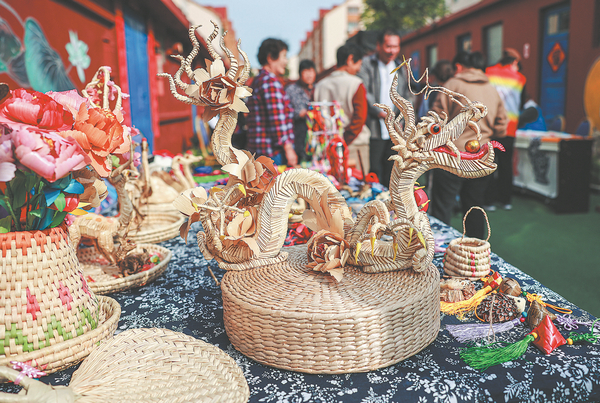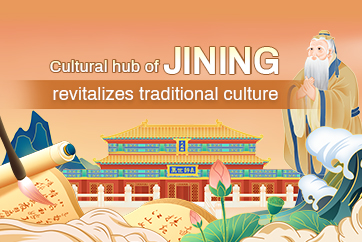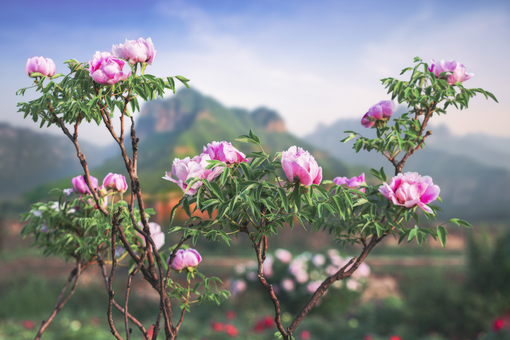Folk artists along the Yellow River display seeds of creativity
By ZHAO RUIXUE in Jinan| (China Daily)| Updated : 2023-11-20
Print Print
Intangible cultural heritage inheritors show their products at a Yellow River fair held in Qingshan community in Rongcheng, Shandong province, on Oct 12. LI XINJUN/FOR CHINA DAILY
Han Guorui, a folk artist specializing in making Dongming grain pictures, is generally busy in autumn as he needs to collect materials for his work. This year, he has been even busier, as he has attended fairs to demonstrate his skills and promote grain art.
The grain pictures, which take their name from Dongming county in Heze, Shandong province, are a traditional folk craft with a history of more than 200 years. The practice was listed as a provincial intangible cultural heritage in 2016 by the Shandong Provincial Department of Culture and Tourism.
After being treated to prevent decay and insect infestation, grains, grass and vegetable seeds are glued together to form a picture.
"We use the different shapes and colors of grains and seeds, which are all collected from the field," says Han.
Born in Dongming, a county along the banks of the Yellow River, he attended a regional fair in mid-October. His pictures attracted many children who asked questions, such as, "will these seeds sprout", and "can these grains be eaten?"
Han answered the children's questions while showing them how to use grains and seeds to make a picture.
"Only now, when food is sufficient, can people make a picture with surplus grain," he says.
To make pictures that more people like, Han works in the style of Chinese ink and Western oil paintings. Now his grain pictures are not only sold in cities across China, but also to overseas markets, including some European countries, South Korea and Japan, he says.

Items made from dry corn husks on show at the event. LI XINJUN/FOR CHINA DAILY
"Grain pictures have become a cultural product that is helping to enrich farmers living on the Yellow River plain," says Han.
The Yellow River, the country's second longest, is considered the cradle of Chinese civilization. For thousands of years, the people living along its banks have nurtured rich and vibrant cultures that have endured to this day.
To give people the opportunity to familiarize themselves with its rich culture and plentiful products, Shandong province has organized fairs named after the river throughout the year, with some events held in communities to involve more people.
At the fairs, intangible cultural heritage items, handicrafts, local delicacies, performances, and agricultural products are available.
At one fair in a community in Jinan, the capital city of Shandong, in late October, more than 10 types of handicrafts were on show, including gourd-carving, paper-cutting, textiles and hemp rope weaving.
"The fair builds a bridge between intangible cultural heritage producers and consumers. Using items that are embodied with traditional culture is a good way to pass on culture," says Sun Xicai, deputy director of Jinan Folk Literature and Art Association.
At the fair, 60-something Yu Shaoqing, who was selling animal-shaped textile products, attracted a lot of buyers.
"Many young people show an interest in my products. They buy them to decorate their rooms and cars," says Yu.
Yu, who worked in embroidery design before retiring, designs her products, which take the shape of animals like tigers, rabbits and ducks. Currently, she is working on a dragon design for next year to welcome the Year of the Dragon.
"I have spent eight months drawing more than 10 sketches. I want a dragon that will catch people's attention at first sight," Yu says.
Neighboring a booth at the fair selling products made from woven hemp rope, Yu was inspired to decorate a hemp basket with cloth tigers.
"The fair has not only provided us a platform to promote our products, but also a platform to exchange ideas. Traditional crafts need new ideas to make them popular with modern consumers," she says.

 Statistics: Fun facts about Heze's peonies
Statistics: Fun facts about Heze's peonies  Cultural hub of Jining revitalizes traditional culture
Cultural hub of Jining revitalizes traditional culture  Peonies bloom in Heze
Peonies bloom in Heze